O.S.C.A.
O.S.C.A. (Officine Specializzate Costruzione Automobili—Fratelli Maserati S.p.A.) was an Italian manufacturer of racing and sports cars established 1947 in San Lazzaro di Savena, Bologna, by the Maserati brothers, and closed down in 1967. Its name is usually abbreviated to OSCA or Osca.
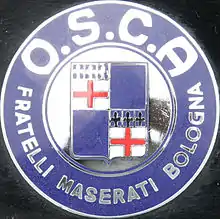 | |
| Industry | Automotive |
|---|---|
| Fate | Ceased production |
| Founded | 1947 |
| Defunct | 1967 |
| Headquarters | San Lazzaro di Savena, Bologna, Italy |
Key people | Ettore, Ernesto and Bindo Maserati |
| Products | Automobiles |
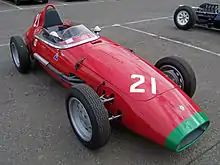
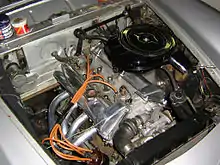

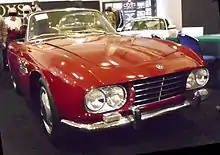
History
O.S.C.A. was founded in 1947 by Ernesto Maserati (engineering manager) and his two brothers Ettore, and Bindo (operations managers) who had all left Maserati after their ten-year contract with Adolfo Orsi terminated. Ten years earlier, in 1937, the remaining Maserati brothers had sold their shares in the company to the Orsi family, who, in 1940, had relocated the company headquarters to their hometown of Modena, where it remains to this day.
The O.S.C.A. factory was located in San Lazzaro di Savena outside Bologna,[1] where Maserati were originally made 1926 to 1940. Their basic business goal was to develop an automobile to compete in the popular Italian 1,100 cc racing class.
O.S.C.A.'s first automobile was the MT4, for Maserati Tipo 4 cilindri. The 1,092 cc engine, which produced (72 PS (53 kW; 71 hp) at 6,000 rpm, had a in-house designed block, alloy head, and the bodywork was built as a two-seater barchetta. The MT4 first raced in 1948 at the Pescara Circuit and the Grand Prix of Naples, where it was driven to a win by Luigi Villoresi. The engine was modified to 1,342 cc form (with 90 PS (66 kW; 89 hp) at 5,500 rpm) in 1949.[2]
In 1950, a new DOHC (MT4-2AD) raised power to a maximum of 100 PS (74 kW; 99 hp) at 6,300 rpm, and in 1953 the engine was enlarged to 1,453 cc, producing 110 PS (81 kW; 108 hp) at 6,200 rpm. The all new tipo 372 DS twin spark engine with 1,491 cc, which produced 120 PS (88 kW; 118 hp) at 6,300 rpm, was later used in the O.S.C.A. MT4 TN (for Tipo Nuovo, "new model") of 1955. With this new engine, the car received the new name FS 372, of which five were built.[3] One of these belongs to Sir Stirling Moss, who raced it in historic races across the globe until his retirement in 2011. Versions of this engine went on to be used in coupé and convertible models of regular Fiats from 1959 to 1966.
These automobiles were mainly barchettas, but a few were built as berlinetta bodies by Pietro Frua and Vignale. A Vignale bodied MT4 was run in the 1,500 cc class at the 1953 24 Hours of Le Mans.
The 1954 12 Hours of Sebring was won by drivers Stirling Moss and Bill Lloyd in an O.S.C.A. MT4[4] as part of the Briggs Cunningham Team.[5]
From 1951 to 1962, automobiles or engines made by O.S.C.A. also were entered in some Formula One and Formula Two events although they mainly built small sports cars of which some were designed by Pietro Frua. In the World Sportscar Championship OSCA ranked 10th (1953), 4th (1954), 6th (1957), 5th (1958) and 4th (1961).
The 750 cc 70 hp (52 kW) type S 187 was introduced in 1956. Weighing 430 kg (948 lb), this car had a top speed of 110 mph (180 km/h). The name "187" refers to the displacement in cubic centimetres of each cylinder of the engine. In 1959 Jim Eichenlaub won the American H-Mod Title with this OSCA S 187. Operating on a shoestring budget, Eichenlaub often slept in his tow car because there was no money for a motel. However he won his first race at Pensacola in April 1959.[6]
The Formula Junior (FJ) used a Fiat engine of 1089 cc, and saw wins by Colin Davis and Berardo Taraschi in 1959.
In 1963 the brothers sold the company to Count Domenico Agusta, owner of MV Agusta,[1] They did design work for Agusta until 1966. One of their final designs was a desmodromic four-cylinder engine. O.S.C.A. ended operations in 1967.
OSCA Fiats
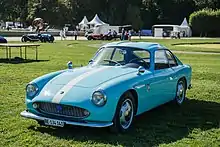
The 1500S Coupé and Convertible were available with OSCA's twin cam 1491 cc engine as the 1200 were produced with a Fiat engine. These 90 PS (66 kW) 1500S models went on sale in November 1959, with Pininfarina bodywork. The engine was uprated to 1568 cc and 100 PS (74 kW) in the summer of 1962 (1600 S) thanks to a 2 mm bore increase, and the shell underwent a facelift as the Fiat 1300/1500 replaced the original 1200 in 1963. This continued in production until replaced by the Fiat 124 coupé/spider, with Fiat's own twin cam engine, in late 1966. OSCA also offered their own cars powered by a derivative of this engine, such as the Fissore-bodied 1600 GT2 and the more attractive Zagato GT and GTS.
Vehicles
Name and year of introduction:
- Osca MT4 (1947)
- Osca S187 (1956)
- Osca 750S (1957)
- Osca 1100 FJ (for Formula Junior)
- Osca 1100 (1960)
- Osca 2000 Desmodromico (Morelli, 1959/60)
- Osca 1600 GT2 (1962)
- Osca 1600 SP (1963)
Complete Formula One World Championship results
| Formula One World Championship career | |
|---|---|
| Engines | OSCA |
| Entrants | OSCA, Élie Bayol, Louis Chiron |
| First entry | 1951 Italian Grand Prix |
| Last entry | 1958 Monaco Grand Prix |
| Races entered | 7 (4 starts) |
| Race victories | 0 |
| Constructors' Championships | 0 |
| Drivers' Championships | 0 |
| Points | 0 |
| Pole positions | 0 |
| Fastest laps | 0 |
| Formula One World Championship career | |
|---|---|
| First entry | 1951 Italian Grand Prix |
| Last entry | 1962 Italian Grand Prix |
| Races entered | 12 (8 starts) |
| Chassis | OSCA, Maserati, Cooper, De Tomaso |
| Constructors' Championships | 0 |
| Drivers' Championships | 0 |
| Race victories | 0 |
| Podiums | 0 |
| Points | 0 |
| Pole positions | 0 |
| Fastest laps | 0 |
As a constructor
(key) (results in bold indicate pole position; results in italics indicate fastest lap)
| Year | Entrant | Chassis | Engine | Tyres | Driver | 1 | 2 | 3 | 4 | 5 | 6 | 7 | 8 | 9 | 10 | 11 | WCC | Points |
|---|---|---|---|---|---|---|---|---|---|---|---|---|---|---|---|---|---|---|
| 1951 | OSCA Automobili | 4500G | 4500 4.5 V12 | P | SUI | 500 | BEL | FRA | GBR | GER | ITA | ESP | N/A1 | |||||
| 9 | ||||||||||||||||||
| 1952 | Élie Bayol | 20 | 2000 2.0 L6 | P | SUI | 500 | BEL | FRA | GBR | GER | NED | ITA | N/A1 | |||||
| Ret | ||||||||||||||||||
| 1953 | Louis Chiron | 20 | 2000 2.0 L6 | P | ARG | 500 | NED | BEL | FRA | GBR | GER | SUI | ITA | N/A1 | ||||
| 15 | DNS | DNS | 10 | |||||||||||||||
| Élie Bayol | 20 | 2000 2.0 L6 | P | Ret | DNS | Ret | ||||||||||||
| 1958 | OSCA Automobili | F2 | 372 1.5 L4 | P | ARG | MON | NED | 500 | BEL | FRA | GBR | GER | POR | ITA | MOR | NC | 0 | |
| DNQ | ||||||||||||||||||
| DNQ | ||||||||||||||||||
| Source:[7] | ||||||||||||||||||
As an engine supplier
(key) (Races in bold indicate pole position; races in italics indicate fastest lap)
| Year | Entrant | Chassis | Engine | Tyres | Drivers | 1 | 2 | 3 | 4 | 5 | 6 | 7 | 8 | 9 | WCC | Points |
|---|---|---|---|---|---|---|---|---|---|---|---|---|---|---|---|---|
| 1951 | Prince Bira | Maserati 4CLT/48 | 4500 4.5 V12 | P | SUI | 500 | BEL | FRA | GBR | GER | ITA | ESP | N/A1 | |||
| Ret | ||||||||||||||||
| 1959 | OSCA Automobili | Cooper T43 | 2.0 L4 | D | MON | 500 | NED | FRA | GBR | GER | POR | ITA | USA | NC | 0 | |
| Ret | ||||||||||||||||
| 1961 | Scuderia Serenissima | De Tomaso F1 | 372 1.5 L4 | D | MON | NED | BEL | FRA | GBR | GER | ITA | USA | NC | 0 | ||
| Ret | ||||||||||||||||
| Scuderia Settecolli | De Tomaso F1 | 372 1.5 L4 | D | Ret | ||||||||||||
| 1962 | Scuderia Settecolli | De Tomaso F1 | 372 1.5 L4 | D | NED | MON | BEL | FRA | GBR | GER | ITA | USA | RSA | NC | 0 | |
| DNQ | ||||||||||||||||
| Source:[8] | ||||||||||||||||
- Notes
References
- Celebrating the 60th anniversary of the founding of O.S.C.A. from maserati-alfieri.co.uk
- story from maserati-alfieri.co.uk
- Melissen, Wouter (2009-11-09). "OSCA FS 372 Morelli Spider". Ultimatecarpage.com. Retrieved 2013-02-02.
- Stefan Dierkes. "Pietro Frua (1913-1983) - OSCA MT4-2AD 1953". Pietro-frua.de. Retrieved 2010-07-04.
- In the April 6, 1992 issue of AutoWeek, Cunningham stated that, of all the automobiles he built, owned, and raced, O.S.C.A. was his favorite racecar.
- "OSCA S187 1959". La Galerie Des Damiers. 1959-05-17. Archived from the original on 2013-11-04. Retrieved 2014-10-18.
- "Constructors - OSCA". statsf1. Retrieved 24 August 2018.
- "Engines - OSCA". statsf1. Retrieved 24 August 2018.
External links
| Wikimedia Commons has media related to OSCA vehicles. |